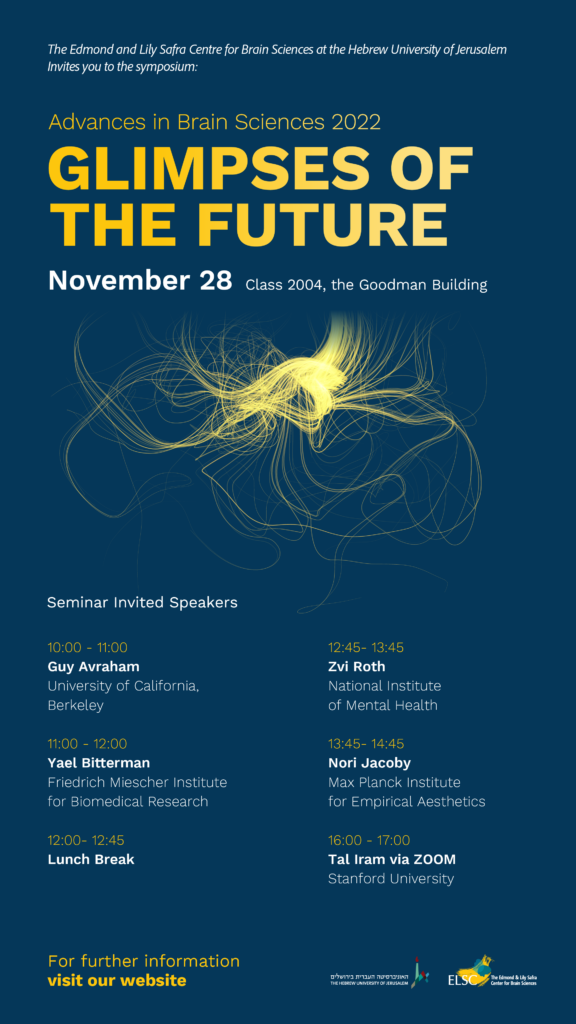The Edmond and Lily Safra Center for Brain Sciences at the Hebrew University of Jerusalem Invites you to the symposium:
Advances in Brain Sciences
2022
Glimpses of the future
November 28, 2022
Room 2004, Goodman building, Safra Campus
Seminar Invited Speakers:
10:00-11:00- Guy Avraham
University of California, Berkeley
Movement as a Window into Cognition
The human motor system is an interface for the interaction between mind, body, and environment. It supports the expression of our mental activity, from the reflexive responses elicited by sensory events to the intentional actions that result from high cognitive functions. Despite this dependence, research on motor control and sensorimotor learning has largely occurred without deep consideration of fundamental insights that have resulted from the cognitive revolution. Instead, the motor literature has been mainly grounded in ideas from the engineering world, looking at movements as being governed by implicit processes that follow the computational rules of control theory. I will present three projects demonstrating the benefits of applying well-established ideas from the cognitive domain in the study of motor control. In one project, I will show how the seminal distinction between explicit and implicit learning systems reveals opposite patterns of expression for sensorimotor memories upon relearning, with the explicit system driving savings, whereas the implicit system exhibits a surprising attenuation. In the second project, I apply ideas about memory interference to develop a mechanistic account for attenuation in sensorimotor learning. In the third project, I will build on the classical conditioning literature to propose a new framework for modeling sensorimotor learning, and present results showing the utility of an association perspective in understanding the effect of context on learning. In terms of future directions, I will discuss the benefits of an integrative motor-cognition research approach, asking how we can apply what we learn from the motor domain to ask novel questions about the neural mechanisms that support cognitive processes.
11:00-12:00- Yael Bitterman
Friedrich Miescher Institute for Biomedical Research
Structures in space and time – Hierarchical network dynamics in the amygdala
In addition to its role in the learning and expression of conditioned behavior, the amygdala has long been implicated in the regulation of persistent states. Yet, it is not evident what features of the neuronal activity capture the functional role of the network across such different timescales. I will describe our approach for the analysis of calcium imaging data from the basolateral amygdala, collected while mice performed complex, self-paced behavior, including goal directed actions. We show the seemingly complex network dynamics can be effectively described by a hierarchical, modular structure, where repeatedly used, stereotyped dynamical motifs correspond to behavior on a wide range of timescales. The geometric organization of the dynamical motifs supports abstract representation of task parameters and points to network mechanisms involved in the encoding and maintenance of specific motivational control of behavior, a working model that goes well beyond the classical view of amygdala as a brain region primarily attributing value to environmental inputs. We suggest hierarchical spatiotemporal descriptions offer a unified framework that harnesses the current confluence of large-scale neural measurements and novel analytical tools to formulate new hypotheses linking moment-to-moment mesoscale brain network activity to adaptive (and maladaptive) behavior across scales.
12:45-13:45- Zvi Roth
National Institute of Mental Health
Inside Out: How brain states impact sensory processing
Neural representations in primary sensory cortical regions are often thought to encode stimulus information in a stable manner, providing the rest of the brain with a reliable representation of the external word. But a growing body of findings suggests this is not the case. Instead, sensory representations are influenced by numerous factors related to internal brain states. In this talk, I will describe studies combining computational theory, high-resolution fMRI, and naturalistic stimuli to understand visual representations in the human brain. I will then discuss recent work describing how visual cortex is influenced by internal brain signals, such as arousal and reward expectancy, and how such internal factors evolve over time. Finally, I will outline planned research directions that will elucidate how brain states impact sensory processing.
13:45-14:45- Nori Jacoby
Max Planck Institute for Empirical Aesthetics
Mapping internal representations with adaptive sampling and massive online experiments
Human perception is rich, multi-dimensional, and contextual. Yet behavioral methods are often biased by their limitation to simplified, one-dimensional stimulus spaces. My research addresses this gap by developing adaptive sampling methods inspired by Monte Carlo Markov Chain techniques, in which each successive stimulus is dependent on a subject’s response to the previous stimulus. This process allows us to sample from the complex and high-dimensional joint distribution associated with internal representations and obtain high-resolution maps of perceptual spaces. After introducing these methods and describing their implementation via large-scale online experiments, I demonstrate how they can be applied to obtain theoretical and empirical insights into fundamental questions in neuroscience and cognitive science, with a particular focus on the role of biology and culture in forming internal representations and the characterization of semantics in perception.
16:00-17:00- Tal Iram via ZOOM
Stanford University
Oligodendrocyte plasticity in cognitive aging and neurodegeneration
Tal received her PhD in Neuroscience from Tel Aviv University in Israel in 2017. Shortly after, she began her postdoc in the Wyss-Coray lab at Stanford where she developed a novel rejuvenation paradigm by transferring cerebrospinal fluid (CSF) from young to aged mice. This led her to study oligodendrocyte rejuvenation in the aging hippocampus in the context of cognitive aging. She identified that Fgf17, a CSF growth factor that decreases with age, is sufficient for oligodendrocyte rejuvenation and for improvements in cognitive function.

